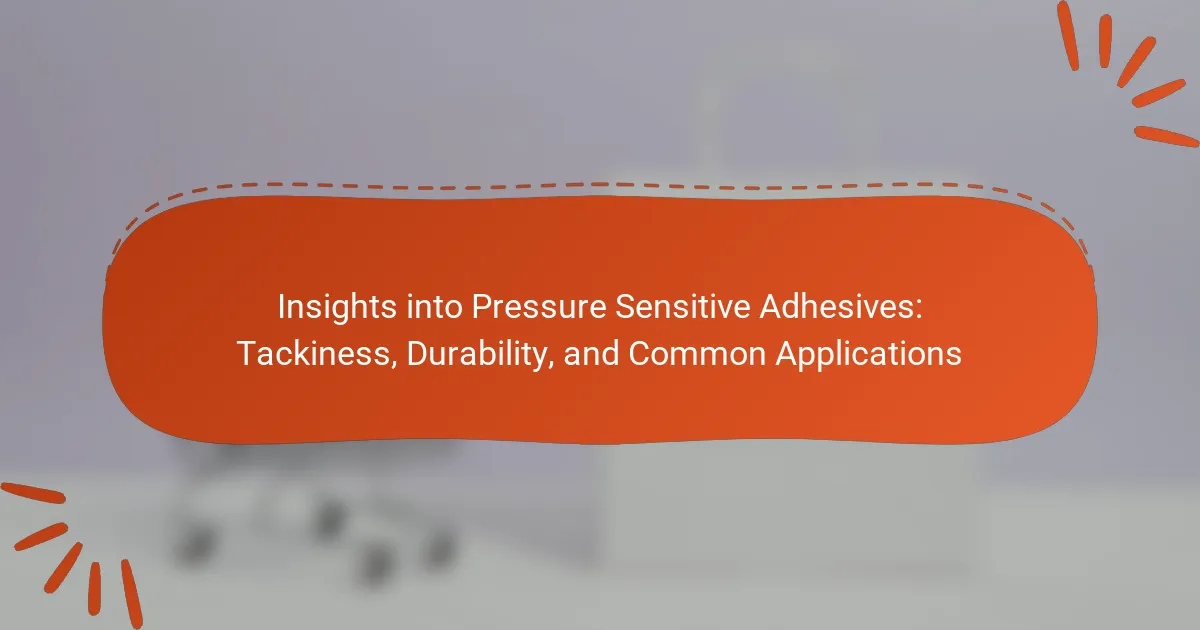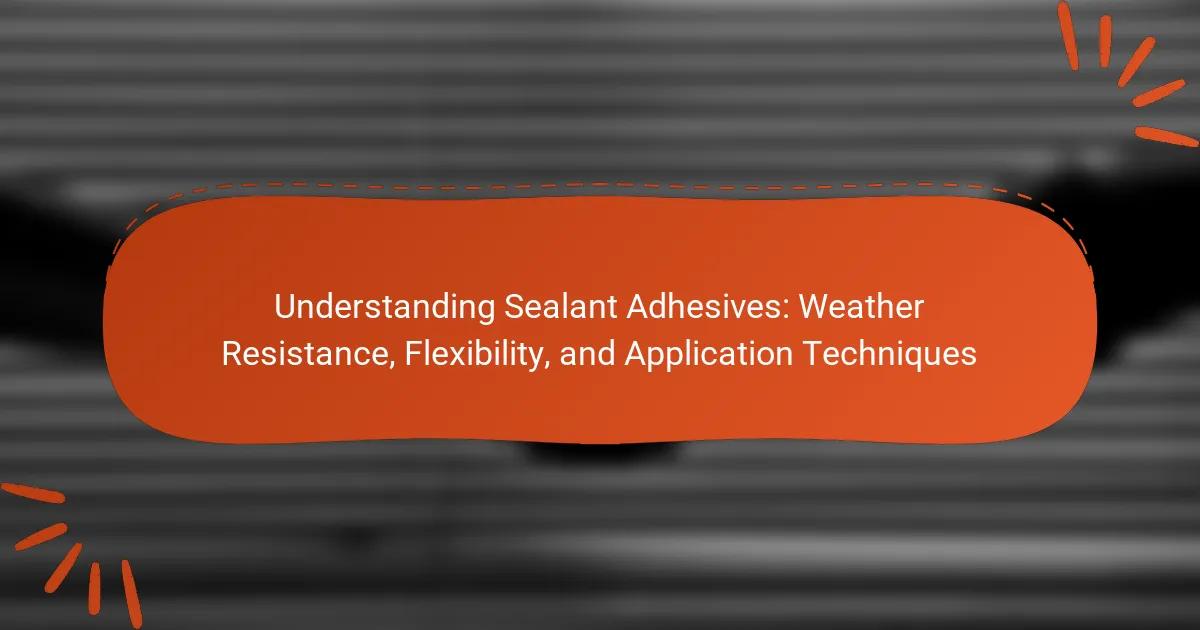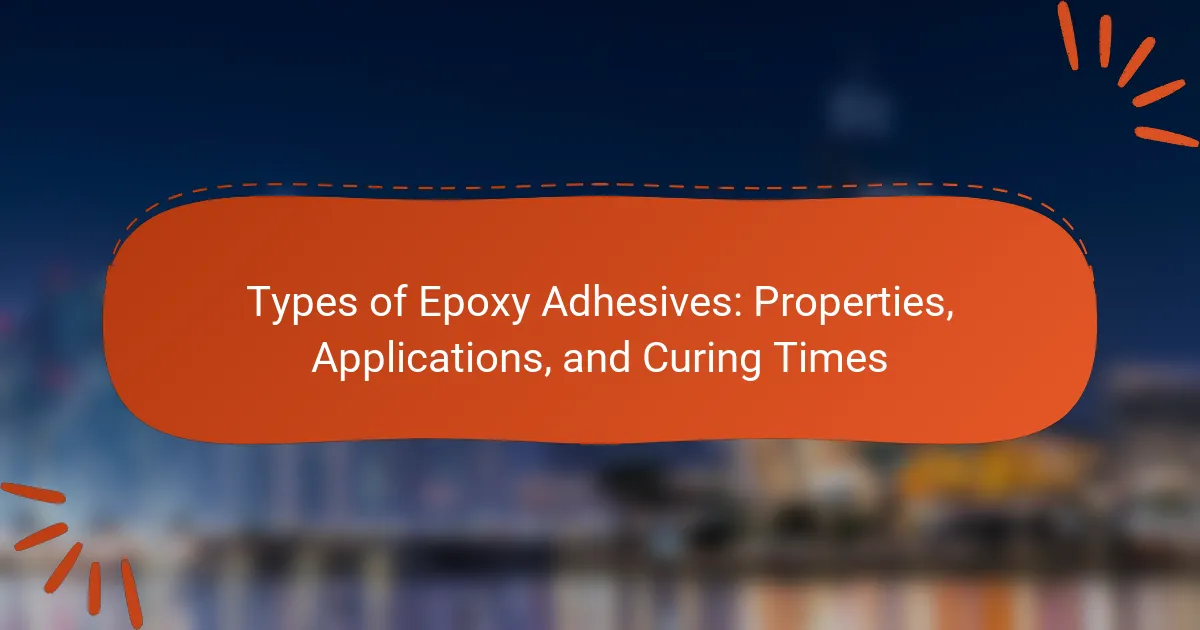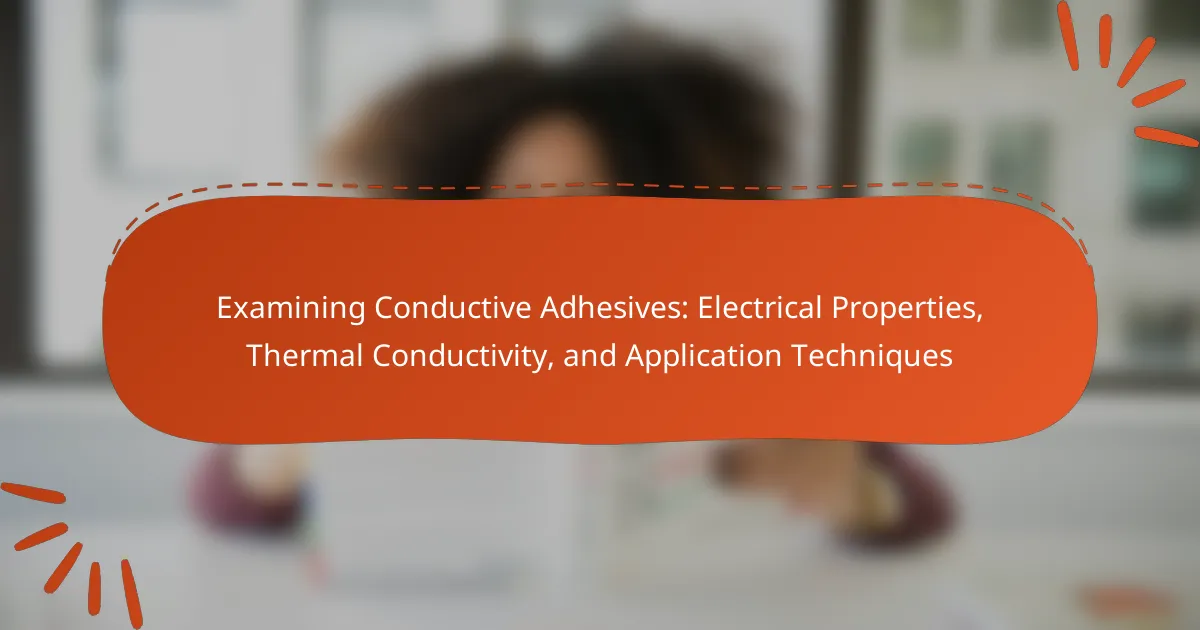Pressure sensitive adhesives (PSAs) are adhesives that bond to surfaces through light pressure without the need for heat or solvents. This article provides insights into the critical properties of PSAs, such as tackiness and durability, and explores their diverse applications across various industries, including automotive, electronics, and medical devices. The discussion highlights how tackiness influences adhesive performance and the factors affecting the durability of PSAs in different environments. Additionally, the growing global demand for PSAs underscores their significance in manufacturing labels, tapes, and other bonding solutions.
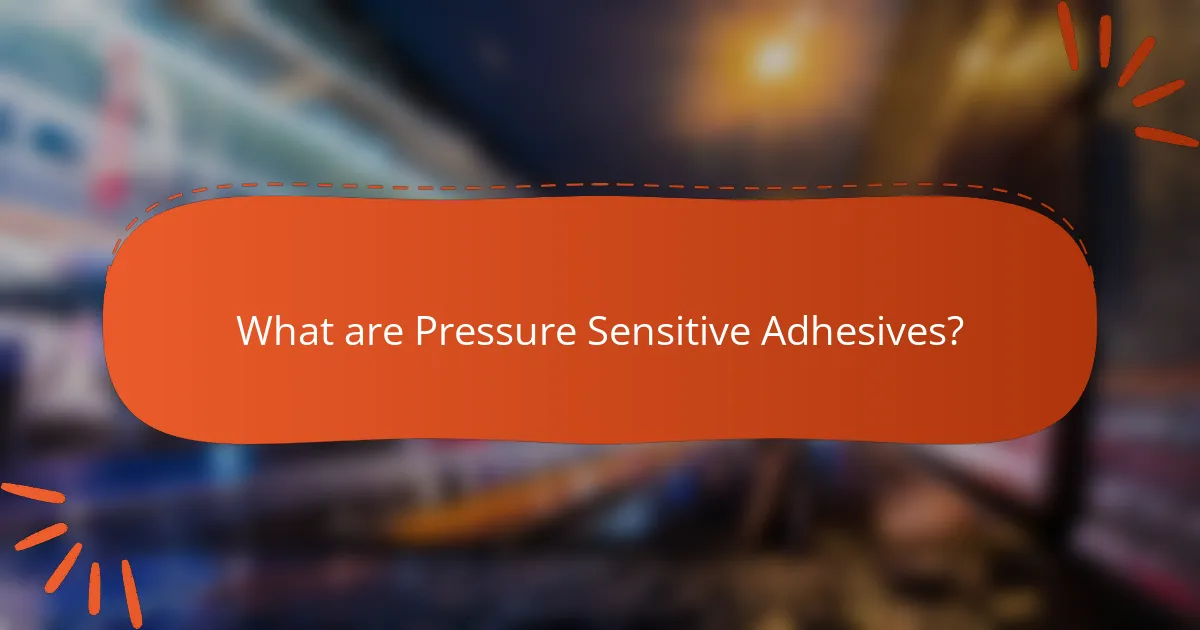
What are Pressure Sensitive Adhesives?
Pressure sensitive adhesives are a type of adhesive that bonds to surfaces with the application of light pressure. They do not require heat or solvents to activate. These adhesives maintain their bond strength over time. They are used in various applications, including tapes, labels, and medical devices. Their unique property allows for easy repositioning and removal without leaving residue. The versatility of pressure sensitive adhesives makes them essential in many industries. They are formulated from polymers, often acrylics or rubber-based materials.
How do Pressure Sensitive Adhesives work?
Pressure Sensitive Adhesives (PSAs) work by forming a bond when pressure is applied. They do not require heat or solvents to activate. PSAs consist of a polymer matrix that provides tackiness. When pressed against a surface, the adhesive flows slightly to create contact. This contact allows for adhesion to occur. The bond remains strong until a sufficient force is applied to separate the materials. PSAs are used in various applications, including tapes, labels, and medical devices. Their effectiveness is due to the balance of cohesive and adhesive properties within the polymer.
What are the key components of Pressure Sensitive Adhesives?
The key components of Pressure Sensitive Adhesives (PSAs) include a polymer matrix, tackifiers, and additives. The polymer matrix provides the adhesive’s fundamental structure and bonding properties. Common polymers used are acrylics, rubber, and silicone. Tackifiers enhance the adhesive’s tackiness and improve its performance on various surfaces. Additives can include plasticizers for flexibility, stabilizers for UV protection, and fillers for cost efficiency. These components work together to ensure that PSAs adhere well without requiring heat or solvent activation.
How do these components influence tackiness and durability?
The components of pressure sensitive adhesives (PSAs) significantly influence their tackiness and durability. Tackiness is affected by the formulation of the adhesive, including the choice of polymers and additives. Higher levels of tackifying resins generally enhance the adhesive’s grip on surfaces. Conversely, the presence of plasticizers can improve flexibility but may reduce overall tackiness.
Durability is influenced by the chemical composition of the adhesive. For instance, specific polymers can provide better resistance to environmental factors, such as temperature and moisture. Enhanced durability often results from cross-linking agents that improve the adhesive’s strength over time.
Research indicates that the balance between tack and durability must be carefully managed. A study published in the Journal of Adhesion Science and Technology highlights that optimizing resin types directly correlates with improved performance metrics in PSAs. This evidence supports the assertion that component selection is critical in achieving desired adhesive qualities.
What are the different types of Pressure Sensitive Adhesives?
The different types of Pressure Sensitive Adhesives (PSAs) include rubber-based, acrylic-based, and silicone-based adhesives. Rubber-based PSAs are known for their excellent initial tack and adhesion to a variety of surfaces. Acrylic-based PSAs offer good UV resistance and temperature stability. Silicone-based PSAs are known for their high-temperature resistance and are often used in specialized applications. Each type serves distinct purposes and is chosen based on specific requirements such as adhesion strength and environmental conditions.
What are the characteristics of acrylic adhesives?
Acrylic adhesives are known for their strong bonding capabilities and versatility. They exhibit excellent adhesion to a variety of substrates, including metals, plastics, and glass. These adhesives are resistant to environmental factors such as moisture, UV light, and temperature fluctuations. Acrylic adhesives also provide good flexibility and can maintain their bond strength under stress. Their curing process is relatively fast, allowing for quicker application. Additionally, they can be formulated to be either pressure-sensitive or structural adhesives, depending on specific needs. Studies show that acrylic adhesives can achieve high shear and peel strength, making them suitable for demanding applications.
How do rubber-based adhesives compare to other types?
Rubber-based adhesives offer strong initial tack and flexibility compared to other types. They bond quickly to various surfaces and maintain adhesion under stress. Unlike acrylic adhesives, rubber-based options typically provide better immediate bonding strength. However, they may have lower temperature resistance than silicone adhesives. Rubber-based adhesives are also less suitable for prolonged exposure to UV light compared to some other types. Their performance in outdoor applications may be limited due to environmental factors. Overall, rubber-based adhesives excel in applications requiring quick adhesion and flexibility.
What factors affect the performance of Pressure Sensitive Adhesives?
The performance of Pressure Sensitive Adhesives (PSAs) is affected by several factors. These include the adhesive formulation, surface energy of the substrates, and environmental conditions. The formulation determines the tackiness and bonding strength of the adhesive. Substrates with high surface energy enhance adhesion. Conversely, low surface energy can hinder performance. Environmental factors such as temperature and humidity also play a critical role. High temperatures can reduce viscosity, while humidity can affect curing and adhesion. Additionally, the application method impacts performance. Proper application ensures optimal contact between adhesive and substrate. Each of these factors contributes significantly to the overall effectiveness of PSAs.
How does temperature influence adhesive tackiness?
Temperature significantly influences adhesive tackiness. As temperature increases, the mobility of adhesive molecules improves. This enhanced mobility leads to increased tackiness. Conversely, lower temperatures reduce molecular movement. Reduced movement results in decreased tackiness. Research shows that pressure-sensitive adhesives exhibit optimal performance within specific temperature ranges. For example, adhesives may lose effectiveness below their glass transition temperature. This phenomenon is crucial for applications requiring reliable adhesion.
What role does surface energy play in adhesion strength?
Surface energy significantly influences adhesion strength. High surface energy materials tend to form stronger adhesive bonds. This is because they promote better wetting and spreading of adhesive substances. When an adhesive spreads well, it maximizes contact area. Increased contact area leads to enhanced mechanical interlocking. Additionally, surface energy affects molecular interactions at the interface. Stronger intermolecular forces result in higher adhesion strength. Research shows that materials with surface energy above 30 mN/m typically exhibit good adhesion properties. This correlation is crucial in the design of effective pressure-sensitive adhesives.
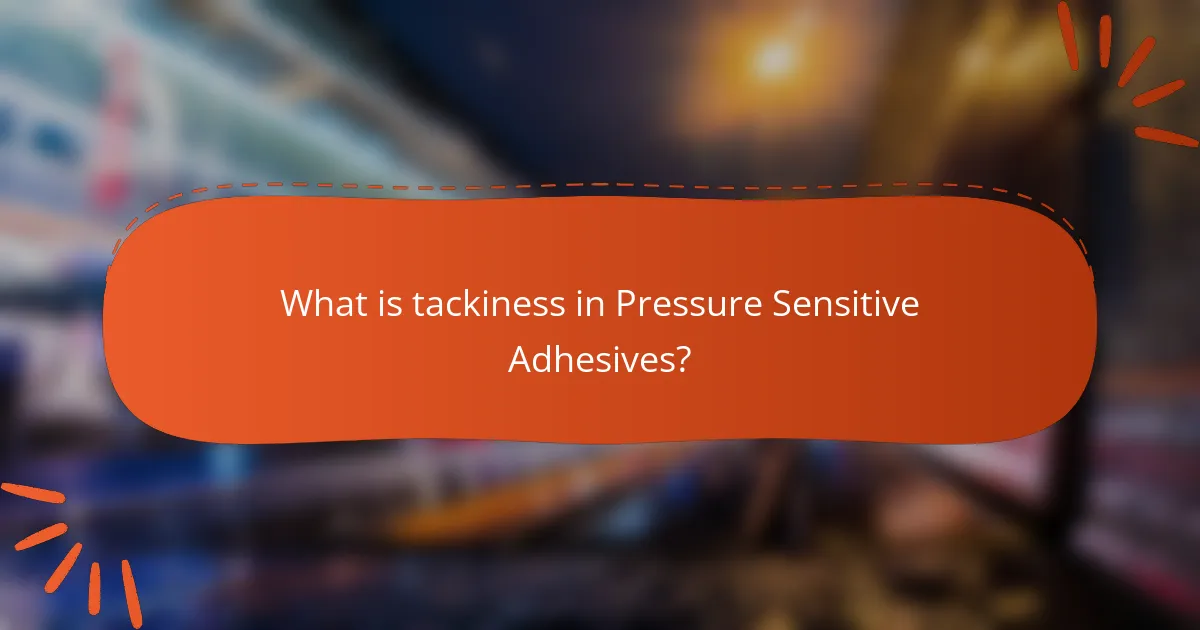
What is tackiness in Pressure Sensitive Adhesives?
Tackiness in Pressure Sensitive Adhesives (PSAs) refers to the adhesive’s ability to bond to surfaces upon contact without the need for additional heat or solvents. It is a critical property that determines how effectively the adhesive adheres to various substrates. High tackiness allows for immediate adhesion, making it suitable for applications requiring instant bonding. The level of tackiness can vary based on the adhesive formulation and environmental conditions. For instance, a higher tackiness is often desired in applications like tape and labels. Studies indicate that tackiness is influenced by factors such as the chemical composition of the adhesive and the surface energy of the materials being bonded.
How is tackiness measured in Pressure Sensitive Adhesives?
Tackiness in Pressure Sensitive Adhesives (PSAs) is measured using standardized tests. One common method is the “peel test,” which assesses the force required to detach the adhesive from a substrate. This test provides quantitative data on the adhesive’s tackiness. Another method is the “shear test,” which measures the adhesive’s resistance to sliding under a constant load. Both tests help determine the performance characteristics of PSAs. These measurements are essential for ensuring the adhesive meets specific application requirements.
What are the different methods for evaluating tackiness?
The different methods for evaluating tackiness include the probe tack test, peel test, and shear test. The probe tack test measures the adhesive’s initial tack by pressing a probe onto the adhesive surface and measuring the force required to detach it. The peel test assesses the adhesive’s performance by applying a force to peel a bonded surface away at a specific angle. The shear test evaluates the adhesive’s resistance to sliding under a constant load over time. Each method provides quantifiable data on tackiness, ensuring accurate assessments for various applications.
How does tackiness impact the usability of adhesives?
Tackiness significantly impacts the usability of adhesives. It determines how well an adhesive can bond to surfaces upon contact. High tackiness allows for immediate adhesion, which is crucial in applications requiring instant bonding. Conversely, low tackiness may lead to weak bonds or delayed adhesion. For instance, pressure-sensitive adhesives rely on optimal tackiness to function effectively. Research indicates that adhesives with appropriate tack levels perform better in various environments. Thus, the right balance of tackiness enhances the overall performance and effectiveness of adhesives.
Why is tackiness important for specific applications?
Tackiness is crucial for specific applications because it determines the adhesive’s ability to bond surfaces without external pressure. High tackiness allows for immediate adhesion, which is vital in scenarios like medical tape, where quick application is necessary. In packaging, tackiness ensures that seals remain intact during transport. Certain industrial applications require strong initial tack to prevent slippage or movement of materials. Research has shown that pressure-sensitive adhesives with optimal tackiness can enhance performance in various environments. For example, a study published in the Journal of Adhesion Science and Technology highlighted the effectiveness of high-tack adhesives in automotive applications, improving assembly efficiency.
What are the implications of low tackiness in certain scenarios?
Low tackiness in pressure-sensitive adhesives can lead to reduced bonding effectiveness. This is particularly significant in applications requiring strong adhesion. For example, low tackiness may cause materials to peel away easily. This can compromise the integrity of labels or protective films. Additionally, low tackiness may result in difficulty during application. The adhesive may not conform adequately to surfaces. This can lead to air pockets and decreased performance. In scenarios like medical applications, low tackiness can affect skin adhesion. This may result in discomfort or detachment. Therefore, understanding the implications of low tackiness is crucial for effective adhesive selection.
How can high tackiness benefit specific industries?
High tackiness can significantly benefit industries by enhancing adhesive performance. In the packaging industry, high tackiness ensures secure seals that prevent product leakage. This is crucial for maintaining product integrity during transport and storage. In the automotive sector, high tackiness aids in bonding components, improving structural integrity. This results in enhanced safety and durability of vehicles. In the healthcare industry, high tackiness is essential for medical tapes and bandages, ensuring they stay in place during use. This is vital for effective treatment and patient comfort. Additionally, in the construction industry, high tackiness enables better adhesion of materials, reducing the risk of failure in installations. Overall, high tackiness improves the reliability and effectiveness of adhesive applications across various sectors.
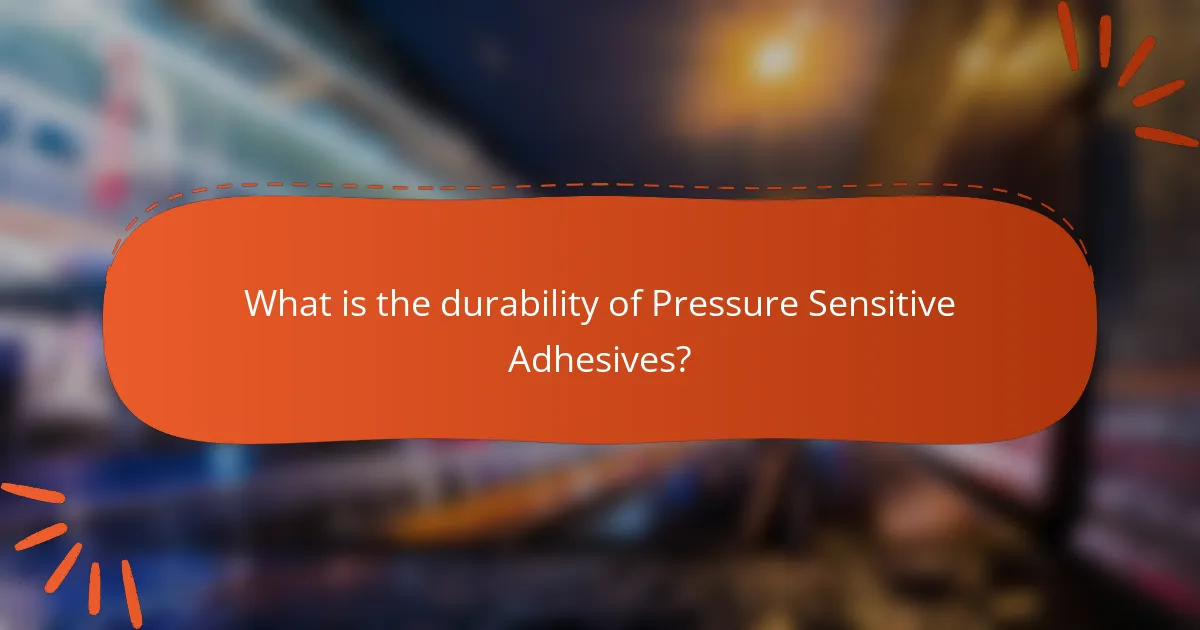
What is the durability of Pressure Sensitive Adhesives?
The durability of Pressure Sensitive Adhesives (PSAs) varies based on their formulation and application. Generally, PSAs can last from a few months to several years. Factors affecting durability include environmental conditions, surface materials, and stress factors. For instance, PSAs used in outdoor applications may degrade faster due to UV exposure. Conversely, those designed for high-performance applications can exhibit extended durability. Research indicates that specific PSAs can maintain adhesion for over five years under optimal conditions. Therefore, the selection of the right PSA is crucial for achieving desired durability in specific applications.
How is durability defined in the context of Pressure Sensitive Adhesives?
Durability in the context of Pressure Sensitive Adhesives (PSAs) refers to the adhesive’s ability to maintain its performance over time under various conditions. This includes resistance to environmental factors such as temperature fluctuations, humidity, and UV exposure. Durability also encompasses the adhesive’s capacity to withstand mechanical stress, such as shear and peel forces, without losing adhesion. Studies indicate that PSAs with higher durability typically feature enhanced chemical formulations and improved substrate compatibility. For example, certain acrylic-based PSAs are known for their long-lasting performance in outdoor applications due to their superior resistance to aging and degradation.
What factors contribute to the longevity of adhesive bonds?
The longevity of adhesive bonds is influenced by several key factors. These include the type of adhesive used, surface preparation, environmental conditions, and the materials being bonded. The chemical composition of the adhesive determines its resistance to aging and degradation. Proper surface preparation enhances adhesion by removing contaminants and increasing surface area. Environmental conditions such as temperature and humidity can affect the curing and performance of the adhesive. Additionally, the compatibility of the bonded materials plays a crucial role in maintaining the bond over time. Research indicates that adhesives with higher tensile strength and flexibility tend to have longer-lasting bonds.
How does environmental exposure affect adhesive durability?
Environmental exposure significantly affects adhesive durability. Factors such as temperature, humidity, and UV light can weaken adhesive bonds. High temperatures may cause adhesives to soften or degrade. Excessive humidity can lead to hydrolysis, weakening the adhesive’s structure. UV light exposure can result in photodegradation, breaking down adhesive polymers. Studies show that adhesives exposed to harsh environments lose strength over time. For example, a study published in the Journal of Adhesion Science and Technology demonstrated that adhesives subjected to extreme conditions experienced a 30% reduction in bond strength. Thus, environmental factors play a crucial role in determining adhesive longevity and performance.
What are the common failure modes for Pressure Sensitive Adhesives?
Common failure modes for Pressure Sensitive Adhesives (PSAs) include adhesive failure, cohesive failure, and environmental degradation. Adhesive failure occurs when the bond between the adhesive and the substrate breaks. This can happen due to surface contamination or improper surface preparation. Cohesive failure refers to the adhesive itself breaking apart, often due to insufficient adhesive strength or excessive stress. Environmental degradation involves the adhesive losing its properties due to exposure to heat, moisture, or UV light. These failure modes can lead to reduced performance and premature bond failure in various applications.
How can adhesive degradation be identified?
Adhesive degradation can be identified through visual inspection and performance testing. Signs of degradation include discoloration, brittleness, and loss of tackiness. These characteristics can indicate chemical breakdown or environmental damage. Performance testing may involve peel strength and shear tests to assess adhesive effectiveness. Changes in adhesion strength can signal degradation. Additionally, exposure to heat, moisture, or UV light often accelerates degradation. Monitoring these factors helps in early identification of adhesive issues.
What preventive measures can enhance adhesive durability?
Preventive measures that can enhance adhesive durability include proper surface preparation, optimal storage conditions, and the use of compatible materials. Surface preparation involves cleaning and priming surfaces to ensure strong adhesion. This can prevent contamination that weakens the bond. Optimal storage conditions, such as maintaining appropriate temperature and humidity, protect adhesives from degradation. Using compatible materials ensures that the adhesive interacts positively with substrates, reducing the risk of failure. According to the Adhesive and Sealant Council, these practices significantly extend the lifespan of adhesive bonds.
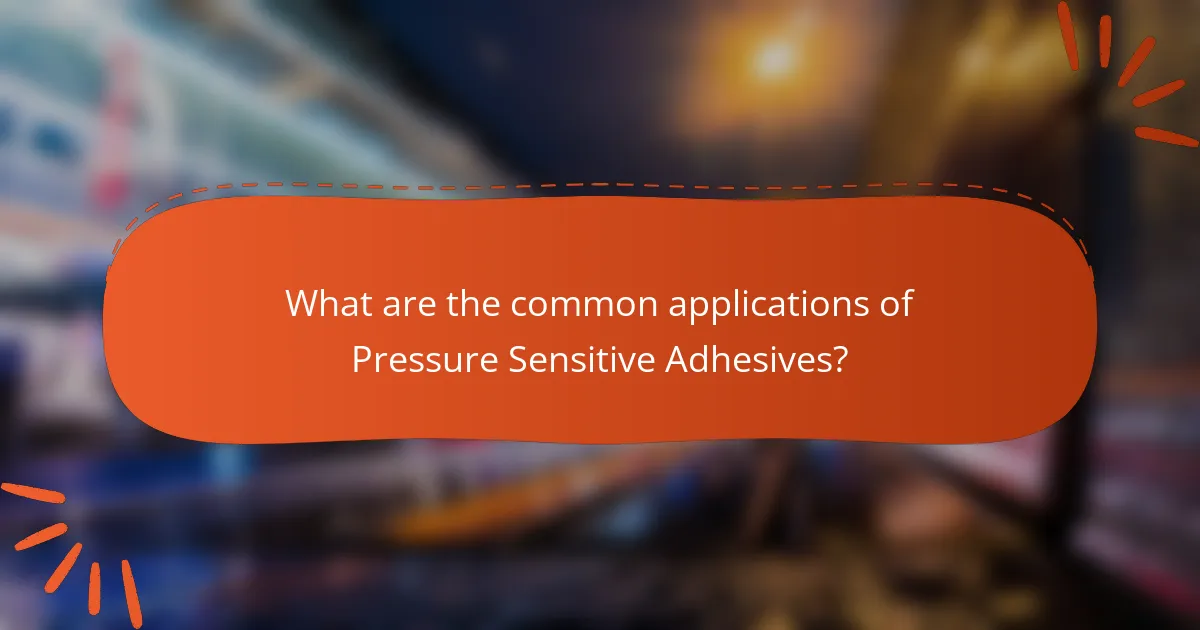
What are the common applications of Pressure Sensitive Adhesives?
Pressure Sensitive Adhesives (PSAs) are commonly used in various applications. They are widely utilized in the manufacturing of labels. This includes product labeling for consumer goods and shipping labels for logistics. PSAs are also essential in the automotive industry. They are used for bonding trim, insulation, and weather stripping.
In the electronics sector, PSAs are applied in assembling components and attaching displays. They are crucial in medical devices, providing secure adhesion for wearable sensors and devices. Additionally, PSAs are found in tapes used for packaging and construction. Their versatility allows for use in both indoor and outdoor applications.
The global demand for PSAs indicates their importance across multiple industries. According to a report by MarketsandMarkets, the PSA market is projected to grow significantly, highlighting their diverse applications.
In which industries are Pressure Sensitive Adhesives most commonly used?
Pressure Sensitive Adhesives (PSAs) are most commonly used in the packaging, automotive, electronics, and medical industries. In the packaging industry, PSAs provide secure seals for labels and cartons. The automotive industry utilizes PSAs for bonding trim and insulation materials. In electronics, PSAs are essential for assembling components and securing displays. The medical industry employs PSAs in adhesive bandages and medical devices. These applications highlight the versatility and effectiveness of PSAs across various sectors.
How do Pressure Sensitive Adhesives function in packaging applications?
Pressure sensitive adhesives (PSAs) function in packaging applications by bonding materials without the need for heat or solvents. They adhere to surfaces upon application of light pressure. This property allows for quick and easy assembly of packaging materials. PSAs create a strong bond that can withstand various environmental conditions. They are often used in labels, tapes, and flexible packaging. The adhesive remains tacky, allowing for repositioning before permanent adhesion occurs. This versatility makes PSAs ideal for various packaging needs. Their effectiveness is supported by their ability to maintain adhesion over time while allowing for easy removal if necessary.
What role do they play in automotive manufacturing?
Pressure sensitive adhesives (PSAs) play a crucial role in automotive manufacturing. They are used for bonding various components without the need for additional heat or solvents. PSAs provide strong adhesion while allowing for flexibility and movement in automotive applications. They are commonly used in the assembly of interior trim, insulation, and exterior panels. This type of adhesive contributes to weight reduction in vehicles, enhancing fuel efficiency. Additionally, PSAs improve manufacturing efficiency by streamlining the assembly process. Their durability ensures long-lasting performance, even under harsh environmental conditions. The automotive industry increasingly relies on PSAs to meet both performance and sustainability goals.
What are some innovative uses for Pressure Sensitive Adhesives?
Innovative uses for Pressure Sensitive Adhesives (PSAs) include medical applications, automotive manufacturing, and electronic devices. In medical settings, PSAs are utilized for wound dressings and transdermal drug delivery systems. These adhesives provide secure attachment while allowing for skin breathability. In automotive manufacturing, PSAs are used for bonding interior components and exterior trims. They enhance durability and reduce weight compared to traditional fastening methods. In electronics, PSAs are employed in the assembly of displays and touchscreens. They ensure strong adhesion while maintaining flexibility. These innovative applications demonstrate the versatility and effectiveness of PSAs across various industries.
How are Pressure Sensitive Adhesives utilized in electronics?
Pressure Sensitive Adhesives (PSAs) are widely utilized in electronics for bonding components without the need for heat or additional solvents. They provide reliable adhesion for various electronic parts, including displays, circuit boards, and sensors. PSAs are crucial in applications such as attaching protective films, mounting components, and insulating materials. Their ability to adhere to different substrates enhances the durability and functionality of electronic devices. Additionally, PSAs offer advantages like flexibility, ease of application, and the potential for repositionability. These characteristics make them ideal for the dynamic requirements of modern electronic manufacturing.
What emerging applications are being explored for Pressure Sensitive Adhesives?
Emerging applications for Pressure Sensitive Adhesives (PSAs) include medical devices, automotive manufacturing, and smart packaging. In the medical field, PSAs are being utilized for wearable sensors and transdermal drug delivery systems. Automotive manufacturers are exploring PSAs for bonding lightweight materials to enhance fuel efficiency. Smart packaging innovations incorporate PSAs for interactive labels that provide real-time information. Additionally, PSAs are being tested in renewable energy sectors for solar panel assembly. These applications highlight the versatility and growing importance of PSAs across various industries.
What best practices should be followed when using Pressure Sensitive Adhesives?
Use clean, dry surfaces for optimal adhesion with Pressure Sensitive Adhesives. Ensure that surfaces are free from dust, grease, and moisture. Apply the adhesive evenly to avoid bubbles or gaps. Use appropriate pressure during application to enhance bonding. Allow adequate curing time as recommended by the manufacturer. Store adhesives in a cool, dry place to maintain their effectiveness. Follow specific guidelines for temperature and humidity during application for best results. Regularly check the adhesive’s performance and replace it if necessary. These practices enhance durability and effectiveness in various applications.
Pressure Sensitive Adhesives (PSAs) are adhesives that bond to surfaces with light pressure without the need for heat or solvents. This article provides an in-depth analysis of PSAs, focusing on their tackiness and durability, as well as their various applications across industries such as packaging, automotive, electronics, and medical sectors. Key components influencing performance, including polymer types and environmental factors, are examined, alongside methods for measuring tackiness and identifying adhesive degradation. Additionally, innovative uses and best practices for utilizing PSAs effectively are discussed, highlighting their essential role in modern manufacturing and product design.
